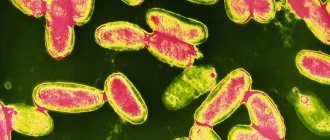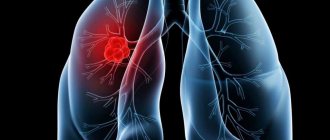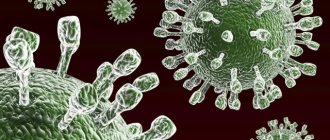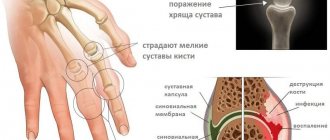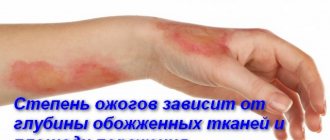Measles has been known since ancient times: the symptoms of this disease were first described in the 9th century by the Arab physician Rhazes. In Russia, the first mention of measles dates back to 1744.
Official registration of cases of measles began only in the middle of the 19th century, and then it was considered primarily a childhood infection with a high mortality rate. Currently, adults are increasingly becoming infected with it; photographs of people with measles presented below give an idea of the visual manifestations of this disease.
Features of the disease
Measles is a disease caused by a virus that is transmitted from a source (an ill person) through the air through talking, coughing and sneezing. This infection is very contagious: the contagiousness of measles is close to 100%. This means that almost every susceptible, that is, non-immune person, will become ill with measles upon contact with the source.
There are no other reservoirs in nature for the measles virus other than humans, although monkeys can be infected in laboratory conditions. Outside the human body, the measles virus does not live long and in a room at a temperature of 20-23 ºС, after 3-4 hours it ceases to be dangerous.
It is sensitive to heat (loses pathogenic properties already at 50 ºС), ultraviolet radiation, and disinfectants (chlorine, alcohol, formaldehyde). But the virus is volatile, and therefore can easily move with air masses inside a building from floor to floor through the ventilation system, or between rooms through a corridor.
Therefore, the possibility of infection in transport and public places is possible, even in the absence of direct contact with the sick person.
Measles infection through household items is unlikely. Before the advent of the vaccine, there was an increase in the incidence of measles due to the accumulation of a sufficient number of susceptible individuals every 2-3 years. Currently, due to mass immunization, these intervals have increased and amount to 8-10 years.
Measles is characterized by seasonality: most often the disease is registered between November and May. The only way to get reliable protection against measles is to get over it, since after vaccination, stable immunity is not always formed for everyone. There is no healthy virus carrier with this disease. Recurrence of measles is extremely unlikely.
Measles - what kind of disease is it?
Measles is an acute, highly contagious disease caused by the measles virus and is accompanied by fever, photophobia, rash and headache. Risk groups include children under 5 years of age and elderly unvaccinated people.
Measles is a common infectious disease that affects 20 million people a year. According to the WHO, in 2000 the virus caused 820,000 vaccine-preventable deaths.
In 2001, WHO and UNICEF developed a plan to halve child mortality by 2005 through worldwide vaccination programs. Although exact data is yet to be obtained, international reports indicate that the target was achieved by 74%.
From 1999 to 2003, global measles mortality fell by 39%, but mortality in Africa and Southeast Asia remained high. In 2005, the World Health Assembly adopted new plans to reduce global measles deaths by up to 90%.
From 2000 to 2008, the number of measles cases reported to WHO and UNICEF fell by 67% (from 852,937 to 278,358). Over the subsequent 8-year period from 2008 to 2019, global measles deaths fell by 78% thanks to widespread vaccination.
From 2019 to 2019, all the work of WHO and UNICEF was successfully undermined by pseudoscientific communities . The success of the anti-vaccination movement increased measles incidence and mortality by 20% in both developed and developing countries.
Types of measles in adults
Typical measles is characterized by the following features:
- ARVI symptoms at the onset of the disease;
- two-wave fever;
- intoxication;
- gradual appearance of a rash on the body;
- conjunctivitis with lacrimation and photophobia.
Measles, the symptoms in adults (a photo of a measles rash makes it possible to distinguish it from spots with rubella, chickenpox or dermatitis) which are usually somewhat more pronounced than in children, sometimes develops atypically:
- The hemorrhagic type of measles is characterized by severe intoxication, damage to the nervous (consciousness disorder) and cardiac (heart failure) systems. The rash with this type of measles is represented by dark hemorrhages on the skin and mucous membranes. Blood may be detected in urine and stool. This form of measles is rare but dangerous and can be fatal and requires hospitalization.
- With the rudimentary (erased) form of measles, the symptoms (catarrhal phenomena and fever, rash) are either mild or absent. This course of the disease often occurs after vaccination, but is rare in unvaccinated people.
- Mitigated (weakened) measles develops if immunoglobulin containing the appropriate antibodies was administered prophylactically during the incubation period of the disease. In this case, the incubation period of the virus can last up to 21 days, and all periods of the disease characteristic of measles are reduced to 1-2 days. The phasing of skin rashes is disrupted. As a rule, there are no complications.
- The abortive form of measles has a typical onset, but by 2-3 days all symptoms of infection disappear. An elevated temperature with this type of disease is observed only on the first day; a pale rash covers only the face and torso. This type of disease occurs in vaccinated people.
- The hypertoxic form of measles is characterized by increased intoxication, high unbreakable temperature, heart failure (shortness of breath, bluish skin around the mouth and fingertips), signs of meningoencephalitis (headache, convulsions, loss of consciousness). Hospitalization in this case is necessary.
Causes of measles
The cause of the spread of infection is always the sick person. The virus enters the air through droplets of saliva released when coughing, sneezing or talking, and then “moves” into the respiratory tract of a nearby child. The patient is considered contagious during the last two days of the incubation period of the virus and up to the 4th day of the rash.
Measles is extremely rare in children under one year of age, because they still have little contact with the outside world and strangers. In addition, newborns are protected by maternal antibodies. In infants, the disease may not proceed quite normally and may be characterized by the following symptoms: lack of fever, slight runny nose, slight redness in the mouth.
At the same time, infants in the first year of life may experience complications that are more severe than measles itself and primarily affect the respiratory and cardiovascular systems.
Children who have recovered from the disease remain immune to the disease until the end of their lives. If the mother has had measles in the past, the child will be resistant to the disease until the age of 3 months. It is this period of time that maternal antibodies are contained in the child’s blood. Also, after vaccinations, immunity develops and the child will be protected from measles.
Stages and degrees of measles in adults
Invading the epithelium of the mucous membranes of the nose, oral cavity, and conjunctiva, the virus is carried by the bloodstream into the lymph nodes, where it multiplies during the incubation period.
After this, it is again thrown into the blood and spreads throughout the body. From this moment the clinical manifestations of the disease begin. If measles proceeds typically, then the following stages of the disease are distinguished.
| Stage of disease development | Duration of the period | Characteristics |
| Incubation period | From 6 to 17 (on average 10) days, when carrying out seroprophylaxis - up to 21 days. | There are no symptoms, but during the last 1-2 days of the period the person is already contagious. |
| Catarrhal (prodromal) period | From 3 to 7 days | Acute onset (up to 38-39 ºС), intoxication and catarrhal syndromes, conjunctivitis. Belsky-Filatov-Koplik spots and measles enanthema at the end of the period. |
| Period of exanthema (rash) | 3, sometimes 4 days | The rash appears in a certain order, from top to bottom. On the first day of the rash, an increase in temperature is observed. At the end of the period, the human body stops secreting the virus. |
| Pigmentation period | 1-1.5 weeks | The rash becomes pigmented (darkens) in the same order in which it appeared on the body. After the rash disappears, the skin may peel off. The patient's condition is stabilized. |
Depending on the intensity of the main symptoms and intoxication, typical measles can be mild, moderate or severe:
- Mild degree - temperature does not exceed 38.5 ºС, catarrhal manifestations (nasal congestion and runny nose, inflammation, sore throat and sore throat, cough) and mild intoxication, no conjunctivitis. A new rise in temperature does not accompany the appearance of a faint rash, which does not cover the entire body; the pigmentation is pale.
- Moderate severity - catarrhal and intoxication (weakness, malaise, headache) syndromes and rash are more pronounced, temperature is 38-39 ºС, two-wave fever is characteristic (on the first day of illness and at the beginning of the period of rash). There may be nausea and vomiting. The face becomes puffy, and the eyelids swell due to conjunctivitis. Complications are possible.
- Severe measles – temperature 39.5 ºС and above, pronounced intoxication and catarrhal symptoms, conjunctivitis. In addition to the main symptoms, there may be intestinal disorders, vomiting, and impaired consciousness. The discharge from the eyes and nose becomes purulent. Nosebleeds occur. The rash is bright, abundant, and tends to merge. There are complications.
The course of measles can be either smooth or complicated when a secondary infection occurs. Existing chronic diseases may worsen.
Treatment
There are no special treatments for measles; the body will cope with the infection on its own. Treatment here is symptomatic, which will alleviate the general condition of the sick child:
- antipyretic drugs for elevated body temperature;
- cough medicines depending on its type (different medicines are used for wet and dry);
- remedies for runny nose and sore throat;
- drink plenty of fluids and stay in bed.
During illness, it is also important to provide the child with the necessary vitamin complexes to maintain immunity, and to lubricate chapped lips with Vaseline.
Symptomatic treatment is carried out at home under the supervision of a pediatrician. The child is admitted to the hospital department if complications begin to develop. If there are complications, therapy is supplemented with antibacterial drugs.
Complications of the disease
Complications usually develop in children under 5 years of age or in adults over 20. The most common of them:
- otitis;
- laryngitis;
- stomatitis;
- encephalitis;
- inflammation of the lymph nodes in the neck;
- bronchopneumonia.
Complications that occur in young children can hardly be called a rare occurrence. That is why the baby needs to be treated under the strict supervision of a local pediatrician. Ideally, the doctor will visit your child at least once every three days.
Why do such consequences occur? Everything is very simple. The measles virus can suppress the immunity of a small patient, and this is an excellent circumstance for the bacteria surrounding the child. They are provided with “free entry” into the baby’s body, and they are not slow to take advantage of this. Depending on the type of bacteria that enters the child’s body, not only the complications listed above may occur. It is quite possible that there may be upset stool, conjunctivitis, and even problems with the central nervous system.
The baby’s immunity decreases at the rash stage and may not recover earlier than in a month. Therefore, during treatment, it is important to follow basic hygiene procedures, and continue to see a doctor even after recovery.
Prevention
The first step in preventing the disease is limiting contact with sick children. A child with signs of this infection should be isolated from other (not sick) children for the entire period when he is contagious. The patient's room should be regularly ventilated, and wet cleaning is also necessary.
Children who have been in contact with the patient are given a special immunoglobulin in the first 5 days after contact, which helps them not get sick. This measure is taken in relation to children who have not previously been vaccinated.
It is important to know! Immunoglobulin is administered only to children with weakened immune systems and under the age of three years.
But the most reliable assistant in preventing measles is vaccination.
Video: how to protect yourself and children from measles
Symptoms of measles in adults
During the incubation period, there are no clinical manifestations of the disease. The beginning of the catarrhal period is always marked by a sharp increase in temperature. The first thing that is affected by the virus is the mucous membranes of the respiratory tract. The presence of catarrhal symptoms, enlargement and tenderness of the cervical lymph nodes are characteristic of ARVI.
The photo shows the main symptoms of measles in adults.
Conjunctivitis is typical for measles, accompanied by photophobia, lacrimation and the gradual appearance of purulent discharge from the eyes.
Vivid intoxication symptoms, nausea, and abdominal pain are extremely unpleasant. Measles has a characteristic sign that is unique to it - Belsky-Filatov-Koplik spots. In adults and children, they appear a day before the period of rashes, localized on the inner surface of the cheeks, sometimes on the gums and lips. They look like white grains with a red rim.
They can be easily identified if examined in advance from photographs, but it is important to remember that the absence of these spots does not rule out measles infection. At the same time, measles enanthema can be seen on the palate - red spots of small (3-5 mm) size and irregular shape.
Measles skin rashes are an allergic reaction of the human body to the protein components of the measles virus. Small raised spots (papules), surrounded by redness, are more likely to unite with each other, the more severe the disease. The fever returns along with the rash.
The spots appear in strict sequence:
- Day 1: First behind the ears and on the nose, then spreads over the entire face and neck, upper back and chest;
- Day 2: torso, shoulders;
- Day 3-4: limbs.
Next, the rash begins to turn pale and pigmented in exactly the same sequence as it appeared, and remains in this form for about another week. The temperature returns to normal, catarrhal symptoms weaken and disappear. Adults tend to have a more severe course of measles than children, and complications are more common.
Etiology
The causative agent of measles is an RNA virus of the genus Morbillivirus, a family of paramyxoviruses, which has a spherical shape and a diameter of 120-230 nm. The virus consists of a nucleocapsid - a minus strand of RNA, three proteins and an outer shell formed by two types of matrix proteins (surface glycoproteins) - one of them is hemagglutinin, the other is a “dumbbell-shaped” protein.
The virus is not stable in the external environment and quickly dies outside the human body from exposure to various chemical and physical factors (irradiation, boiling, treatment with disinfectants).
There is a hypothesis about the origin of the measles virus from the rinderpest virus during the emergence of animal husbandry[3].
Despite its instability to the external environment, there are known cases of the virus spreading over significant distances with air flow through the ventilation system - during the cold season in one single building. Weakened strains of measles virus are used to produce live measles vaccine.
Causes of measles in adults
Measles (symptoms in adults; photographs of their external manifestations must be studied in order to have an idea of the disease) in pre-vaccination times was almost exclusively a childhood infection, so by adulthood, 90% of people had strong immunity against it.
Adults became ill if the measles virus was introduced into places where it had never been found before. Now, thanks to mass vaccination, children are getting sick much less often, and almost half of all sick people are adults. To become infected with measles, two conditions must be met.
What is needed, firstly, is contact with the sick person, and secondly, the absence of specific immunity to measles. In adults, this can happen if the person has not been sick and has not been vaccinated, and does not have specific immunity, or the vaccination was done quite a long time ago and/or once. As a rule, immunity after vaccination does not last longer than 15 years.
Moreover, vaccination may not provide sufficient immunity at all. If an adult has not been sick and has not been vaccinated, his measles often has a typical course, but in a severe form, complications are not uncommon. This is explained by weak immunity and chronic diseases accumulated with age. If you were vaccinated in the past, the disease may be erased.
Content
- 1 Etiology
- 2 Distribution
- 3 Pathogenesis and pathological anatomy
- 4 Clinical picture of typical measles
- 5 Complications
- 6 Atypical (weakened) measles
- 7 Measles in adults
- 8 Measles in immunocompromised patients
- 9 Measles and allergies
- 10 Laboratory data
- 11 Differential diagnosis (DD)
- 12 Treatment
- 13 Prevention 13.1 Safety
- 13.2 Dosage form
- 17.1 In English
Diagnosis of measles in adults
Measles, symptoms in adults (a photo of measles enanthema gives an idea of inflammation of the mucous membrane in the mouth) of which include such an unambiguous sign for making a diagnosis as Belsky-Filatov-Koplik spots along with catarrhal phenomena, conjunctivitis, and later a rash on the body, in its typical course, it is diagnosed based on the clinical picture and epidemiological data.
It is determined whether the patient had measles and whether he was vaccinated; the fact of contact with the source of the disease is clarified. Advanced diagnostics is required at the onset of the disease, with an atypical form of the disease, or with the addition of a secondary infection. Laboratory diagnosis is carried out using virological or serological research methods.
The first method involves identifying the measles virus in blood, urine and swabs from mucous membranes. The virus can be detected already on the first day of the incubation period. The maximum amount of virus circulates in the blood at the end of the catarrhal period and at the beginning of the period of rash, while on the fifth day from the onset of the rash it is no longer there.
Isolation of the virus is a complex and lengthy process, so it is rarely used.
A serological test method for diagnosing measles is the detection of specific IgM class antibodies in the blood. They indicate current or recent measles. They can be detected no earlier than on the first day of the exanthema period. Class M immunoglobulins are an unstable indicator and do not remain in the blood for long (about 3-4 weeks from the onset of the disease).
Additionally, the dynamics of the increase in the titer of class G antibodies (IgG) is examined; for this, a blood test is taken twice, two weeks apart. If they increase fourfold, the diagnosis of measles is confirmed.
IgG antibodies are synthesized by the immune system later than IgM, and it makes sense to test for them no earlier than 4 days from the onset of the rash, but they remain in the body for many years (and after measles - for life) and indicate persistent specific immunity. It is the presence of IgG immunoglobulins that prevents you from getting measles again.
The most modern test for detecting antibodies is the enzyme-linked immunosorbent test (ELISA). This test is quite sensitive, reliable and affordable: the cost of diagnosing measles in paid laboratories does not exceed 800 rubles.
The causative agent of measles
The measles virus is a single strand of RNA coiled into a spiral. It is surrounded by a shell (capsid) of proteins and lipids. And on top of this organism is covered with another protective shell with spine-like projections. The virus has a regular round shape and small dimensions of 120-230 nm.
Properties of measles virus:
- It mainly affects the epithelial cells of the upper respiratory tract , which manifests itself in inflammation of the conjunctiva, throat, larynx, and trachea. Measles also affects the cells of the nervous system. This is associated with severe intoxication, sometimes convulsions and loss of consciousness, inflammation of the membranes of the brain (meningitis). The intestinal mucosa also suffers, causing indigestion.
- Protein particles of the virus shell cause an allergic reaction , which underlies most of the symptoms of the disease: Filatov-Koplik-Velsky spots on the mucous membrane of the cheeks and lips, a rash on the skin and mucous membrane of the palate.
- Decreased immunity is associated with the fact that the virus attacks lymphoid tissue and brain structures that are responsible for immune reactions.
- The virus reduces the activity of macrophages , which are considered bacteria eaters and provide protection against infections. In this regard, 30% of cases end in bacterial complications (pneumonia, otitis, encephalitis)
- The hemagglutination activity of the virus (glues red blood cells into flakes) helps laboratory technicians identify the measles virus in the blood.
- The hemolytic activity of the virus (causes the destruction of red blood cells and is accompanied by the release of hemoglobin into the blood) is also used in laboratory diagnostics.
- The virus causes the formation of multinucleated giant cells. They appear as a result of the fusion of neighboring cells in the tonsils, lymph nodes, and the mucous membrane of the respiratory tract. Their function is to produce new viruses.
- The causative agent of measles increases capillary permeability . The liquid component of the blood comes out through their wall, which causes a runny nose, wet cough, conjunctivitis, and swelling in the superficial areas of the skin.
- Congestion of blood vessels and damage to their walls by the virus causes hemorrhages on the skin and eyes.
- Penetrating into a cell, the measles virus rearranges it in such a way that it turns into a factory for the production of new viruses. The cell produces RNA helices and protein shells for capsids.
- When the virus enters the environment, it dies quite quickly . It does not tolerate sunlight, UV irradiation, high temperatures, and any acids or disinfectants. It dies on its own after 2-3 hours, so disinfection for measles may not be carried out.
The source of infection is a sick person. It becomes contagious already in the last 2 days of the incubation period, when there are still no signs of illness. The virus is released from the body before the 4th day of the rash. That is, a person remains dangerous to others for 7-10 days. The measles virus is transmitted through the air by airborne droplets, droplets of saliva and mucus, when coughing and talking.
How does the measles virus behave in the body?
The virus enters the body of a healthy person through the mucous membrane of the respiratory tract. And from there it goes into the blood, which carries it to the lymph nodes and spleen, where it actively multiplies. This occurs during the incubation period, which lasts 7-17 days. As a result, a new generation of viruses enters the bloodstream a second time and disperses throughout the body. They affect the skin, conjunctiva, oral mucosa, respiratory tract, intestines and central nervous system. The measles virus multiplies on individual islets, forming inflammatory infiltrates. In these areas, cell proliferation occurs, while their membranes dissolve and multinucleated cells are formed.
When to see a doctor
Measles (symptoms in adults, a photo of which shows rashes on the skin and mucous membranes, every medical worker must know and keep in mind) can be diagnosed by a general practitioner, but consultation with an infectious disease specialist and laboratory tests may be required if it proceeds atypically.
The disease begins abruptly, and if the temperature exceeds 39 ºС and the symptoms of intoxication are very pronounced, a doctor is called to the house, especially if there is a suspicion of contact with a person with measles. In the typical course of the disease, treatment can be done at home.
The exception is for patients whose isolation is difficult to ensure - for example, those who stay in closed groups (military units, orphanages and boarding schools), as well as when adequate care is impossible and poor living conditions. Hospitalization of such patients occurs according to epidemiological indications, regardless of the severity of measles.
Patients with immunodeficiencies, severe (hypertoxic or hemorrhagic measles) or complicated course of the disease, and pregnant women are subject to mandatory hospitalization for measles. Even if treatment is carried out at home, medical supervision is required to prevent or timely monitor complications.
Links
| measles in Wiktionary |
| Measles on Wikimedia Commons |
In English
- https://www.nlm.nih.gov/medlineplus/measles.html
- https://www.kidshealth.org/parent/infections/lung/measles.html
- https://www.nlm.nih.gov/medlineplus/ency/article/001569.htm
- https://web.archive.org/web/20150805090051/https://www.cdc.gov/ncidod/diseases/submenus/sub_measles.htm
- https://www.netdoctor.co.uk/diseases/facts/measles.htm
- Center for Disease Control and Prevention
In Russian
- Manual for laboratory diagnosis of measles and rubella (Russian) (pdf). WHO. Retrieved April 14, 2019.
- Measles, educational film
Preventing measles in adults
Nonspecific prevention of measles involves isolating the patient from the beginning of the catarrhal stage until the 4th day of the rash inclusive. Contact persons who have not been sick and not vaccinated are isolated for up to 21 days.
The effectiveness of quarantine measures for measles is reduced, since the appropriate diagnosis cannot be made during the incubation period of the disease, and that is when the sick person becomes infectious. Methods of specific prevention include vaccination and seroprophylaxis.
If an adult has not been vaccinated against measles and did not have it as a child, or if a blood test for class G antibodies shows that he does not have immunity to this disease, it is recommended to get vaccinated. Vaccination of adults is not regulated, but up to 35 years of age this procedure is done in clinics free of charge.
The vaccine is administered twice, with an interval of 3 months.
In the presence of ARVI or exacerbation of chronic diseases, it is recommended to postpone vaccination until recovery. If contact with a source of measles is suspected, then emergency vaccination can be carried out within 72 hours after it. There is also a method of passive seroprophylaxis - the introduction of specific immunoglobulins.
It is advisable to administer serum with antibodies no later than 5 days from the moment of contact with the sick person. This measure, even if it cannot prevent the disease, will significantly ease the course of measles. The effect of the serum lasts 3-4 weeks. If repeated contact with the source of measles occurs, it is recommended to repeat the prophylaxis.
How is measles transmitted?
Measles is a highly contagious disease that is transmitted by airborne droplets ; while sneezing, coughing or talking. Infection is also possible through direct contact with the patient's body secretions - saliva or nasal mucus.
The time when people with measles are contagious begins 3-5 days before the onset of symptoms and ends 5 days after the rash disappears. With visible skin rashes, the risk of infection is highest.
Patients suffering from measles are advised to avoid contact with people who are immunocompromised or who have not received the measles vaccine. These include children under 6 months of age, pregnant women and people with weakened immune systems.
Measles epidemics in European countries often originated in public institutions - hospitals, schools or kindergartens. Regions with low immunization rates often suffer from measles epidemics.
Sometimes local measles outbreaks were caused by immigrants (who is that?) or returning travelers. In 2009, travelers from Germany caused a measles epidemic in Bulgaria; 24,000 infected and 24 dead people were the result.
Treatment methods for measles in adults
There are no drugs that destroy the measles virus. Therefore, treatment is designed to alleviate the patient’s condition and prevent secondary infections.
Medications
First of all, the patient is isolated until at least the fourth day of the rash to prevent the spread of infection. Treatment is usually carried out at home.
The standard of treatment involves both medicinal and non-medicinal methods:
- Bed rest during fever, plus 1-2 days after the temperature drops, with frequent ventilation and wet cleaning of the room. The light in the room should be dim.
- Drink plenty of fluids (water, tea, fruit juices, compotes); good nutrition (dairy products, cereals, vegetables, fruits, dietary meat and fish).
- Vitamin therapy: taking vitamin A 10,000 IU per day is especially important, since patients with measles are deficient. Vitamin C is taken 300-500 mg daily. It is believed that even a single dose of vitamin A at a dose of 200,000 IU reduces the severity of measles and the likelihood of complications.
- Antihistamines (Claritin, Tavegil, Cetrin (price 150-215 rubles)) to relieve discomfort from rashes and catarrhal phenomena.
- Relief of catarrhal syndrome. For a runny nose, use vasoconstrictor drugs (Nazivin, Otrivin (average price 150 rubles)), for conjunctivitis, wash the eyes with a solution of furatsilin, instill Albucid (Sodium Sulfacyl, price from 30 rubles). To treat the throat, local antiseptics are used (Gesoral, Tantum Verde (from 300 rubles), Chlorhexedine (15 rubles)). Antitussive and expectorant drugs are prescribed, for example, Ambroxol (RUB 135-160).
- Antipyretic and anti-inflammatory drugs - if the temperature exceeds 38.5 ºС (with ibuprofen (Nurofen, price from 115 rubles) or paracetamol (Efferalgan (from 150 rubles), Panadol (from 50 rubles)). It is not recommended to use aspirin for measles as an antipyretic.
- Antibacterial therapy is required only when associated infections develop. For uncomplicated measles, its use is not justified and is not recommended.
All medications are prescribed in accordance with the instructions for them.
Folk remedies
Folk remedies (herbal medicine) in the treatment of measles are acceptable only as an additional way to alleviate the patient’s condition:
- Linden decoction (2 tablespoons of flowers, pour 300 ml of water, boil in a water bath for 10-15 minutes, then strain) is drunk as a sedative, diaphoretic and antipyretic, 1-2 tbsp. in a day.
- Raspberry tea (30 g of dry berries, pour 1 tbsp of boiling water and leave for 15 minutes in a warm place, strain) with honey is used as a natural antipyretic. You can drink up to 3 tbsp. on the day of such tea.
- Gargling with herbal infusion (chamomile, sage, calendula - separately or in a mixture). 1 tbsp. l. dry raw materials are infused in a glass of hot water for 30 minutes. and use the strained infusion for rinsing every 3 hours (half a glass per procedure).
- It is recommended to use crushed marshmallow root as an expectorant to relieve cough during measles : 2 tbsp. pour 500 ml of water and boil for 5 minutes, then leave for an hour and take 1 tbsp. l. every 2 hours
Notes
- World Health Organization: Measles. Newsletter No. 286, February 2013
- The incidence of measles in Russia in 2019 decreased by almost six times
- Mark Reimers.
Recent evolutionary changes in the human genome. Retrieved January 8, 2019. - The cause of the measles epidemic in the Netherlands was religious fundamentalists, Lenta.ru (September 12, 2013). Retrieved January 28, 2014.
- https://www.rospotrebnadzor.ru/about/info/news/news_details.php?ELEMENT_ID=8196
- The European Region has seen a record high number of measles cases (Russian). www.euro.who.int (20 August 2018). Retrieved August 22, 2019.
- RKI (Robert Koch Institut), Sentinel der Arbeitsgemeinschaft Masern (AGM) - aktuelle Ergebnisse, Epidemiologisches Bulletin, 37, 2000, 297
- Measles and atopy in Guinea-Bissau. [Lancet. 1996] - PubMed - NCBI
- Frequency of allergic d... - PubMed - NCBI
- Allergic disease and atopic sensitization in children... [Pediatrics. 2009] - PubMed - NCBI
- Early atopic disease and early childhood immunization… [Allergy. 2008] - PubMed - NCBI
- Acute infections, infection pressure, and a… - PubMed - NCBI
- Age at childhood infections and risk of atopy
- Starko KM, Ray CG, Dominguez LB, Stromberg WL, Woodall DF
Reye's syndrome and salicylate use. (English) // Pediatrics. - 1980. - Vol. 66, no. 6. - P. 859-864. - PMID 7454476. - Casteels-Van Daele M., Van Geet C., Wouters C., Eggermont E.
Reye syndrome revisited: a descriptive term covering a group of heterogeneous disorders. (English) // European journal of pediatrics. - 2000. - Vol. 159, no. 9. - P. 641-648. — DOI:10.1007/PL00008399. - PMID 11014461. - Schrör K.
Aspirin and Reye syndrome: a review of the evidence. (English) // Paediatric drugs. - 2007. - Vol. 9, no. 3. - P. 195-204. — DOI:10.2165/00148581-200709030-00008. - PMID 17523700. - Fölster-Holst R., Latussek E.
Synthetic tannins in dermatology—a therapeutic option in a variety of pediatric dermatoses. (English) // Pediatric dermatology. - 2007. - Vol. 24, no. 3. - P. 296-301. — DOI:10.1111/j.1525-1470.2007.00406.x. - PMID 17542884. - Strategies for reducing global meat mortality. (French) // Releve epidemiologique hebdomadaire / Section d'hygiene du Secretariat de la Societe des Nations = Weekly epidemiological record / Health Section of the Secretariat of the League of Nations. - 2000. - Vol. 75, no 50. - P. 411-416. - PMID 11189704.
- Huiming Y., Chaomin W., Meng M.
Vitamin A for treating meats in children. (English) // The Cochrane database of systematic reviews. - 2005. - No. 4. - P. 001479. - DOI:10.1002/14651858.CD001479.pub3. - PMID 16235283. - Measles vaccines: WHO position paper. (French) // Releve epidemiologique hebdomadaire / Section d'hygiene du Secretariat de la Societe des Nations = Weekly epidemiological record / Health Section of the Secretariat of the League of Nations. - 2009. - Vol. 84, no. 35. - P. 349-360. - PMID 19714924.
- Moss WJ, Griffin DE
Measles. (English) // Lancet. - 2012. - Vol. 379, no. 9811. - P. 153-164. — DOI:10.1016/S0140-6736(10)62352-5. - PMID 21855993. - Measles Fact sheet N°286. who.int
(November 2014). Retrieved February 4, 2019. - Order of the Ministry of Health No. 125n dated March 21, 2019 “On approval of the national calendar of preventive vaccinations and the calendar of preventive vaccinations for epidemic indications.” With changes and additions until June 16, 2019 (Russian). garant.ru. Retrieved December 7, 2019.
- ↑ 1 2 3 4 5 6 7 8 9 10 11 12 13 14 15 16 17
(28 August 2009) “Measles vaccines: WHO position paper.”.
Weekly epidemiological record 84
(35): 349–60. PMID 19714924. - Control, Centers for Disease.
CDC health information for international travel 2019 the yellow book / Centers for Disease Control, Prevention. - 2019. - P. 250. - ISBN 9780199948505. - Measles.. Newsletter N°286 (Russian). WHO (March 2016). Retrieved May 2, 2019.
- https://www.remedium.ru/news/detail.php?ID=74843
Possible complications
Measles causes severe weakening of the immune system. Due to immunodeficiency, there is a risk of complications, which, in fact, are the only cause of death in this disease. They can be early (manifest in the catarrhal stage or in the first days of the rash) and late (during the period of pigmentation).
Most often affected:
- ENT organs (otitis, laryngitis, sinusitis, stomatitis);
- digestive system (gastroenteritis, diarrhea, colitis, hepatitis, pancreatitis);
- urinary system (pyelonephritis, cystitis, glomerulonephritis);
- respiratory organs (bronchitis, pleurisy, pneumonia);
- central nervous system (measles encephalitis, meningitis, sclerosing panencephalitis).
The most common complications are otitis (up to 10% of cases), laryngitis, pneumonia (5%), the most severe, although rare, are meningitis and encephalitis. The most insidious and absolutely fatal complication of measles is considered to be subacute sclerosing panencephalitis.
This is a slow lesion of the nervous system, which manifests itself only 6-8 years after the infection and is characterized by mental impairment, mental abnormalities, movement disorders and seizures, and ultimately (in adults after a maximum of 7-8 years) cerebral coma and death.
Measles is a disease that is dangerous because of its complications, especially for adults.
If you know the symptoms of this infection, and study the nature of measles rashes from photos, and also be aware of modern diagnostic methods and standard of treatment, it is quite possible to protect yourself and your loved ones in time with the help of active or passive immunization, or, in extreme cases, if you cannot avoid the disease managed to significantly ease its course.
Literature
- Measles // Encyclopedic Dictionary of Brockhaus and Efron: in 86 volumes (82 volumes and 4 additional). - St. Petersburg, 1890-1907.
- Dobrokhotova A.I.
Measles and the fight against it. - M.: Medgiz, 1959. - 160, [20] p. — 20,000 copies. (in translation) - Handbook of infectious diseases in children. Edited by Professor L. A. Trishkova, Associate Professor S. A. Bogatyreva. Kyiv
- Pathological anatomy of diseases of the fetus and child. A. A. Birkun, V. V. Vlasyuk, P. S. Gurevich, B. S. Gusman and others; Ed. T. E. Ivanovskaya, L. V. Leonova. Moscow Medicine.
- Handbook of differential diagnosis of infectious diseases. Edited by Professor A.F. Frolov, Professor B.L. Ugryumov, Dr. med. Sciences E.K. Trinus. Kyiv
- Harrison's Principles of Internal Medicine 14th edition - Measles (Rubeola) - Anne Gershon.
- Pathologia AUTH. Medical School, Thessaloniki Greece. Edition — professor M. Papadimitriou
- Guide for the local pediatrician. S. Sh. Shamsiev, N. P. Shabalov, L. V. Erman
The difference between measles and rubella
Measles and rubella are caused by different viruses.
Rubella is milder than measles: body temperature does not rise above 38 degrees; but there is pain in the muscles. With rubella, there are no Belsky-Filatov-Koplik whitish spots characteristic of measles on the mucous membrane of the cheeks in the area of the molars. Rubella rashes do not merge, unlike measles; looks like small pink spots.
An unpleasant feature of rubella is damage to the fetus (including genetic mutations) when the mother is infected. Measles, unlike rubella, does not harm a pregnant woman.
Prevention
Passive prevention of measles in adults is carried out by administering immunoglobulin, which is obtained from donor plasma. For greatest effectiveness, the drug is administered no later than 72 hours after contact with the patient. The most effective prevention of measles is vaccination, which is carried out in two stages with an interval of 3 months. Lasting immunity for 10 years is developed after the second injection. In addition, take the following measures as non-specific preventive measures:
- Treat chronic diseases in a timely manner, because they contribute to the deterioration of the immune system and increased susceptibility to pathogenic bacteria and viruses.
- Temporarily isolate the sick family member in a separate room, provide him with an individual set of dishes, bed linen, and towels.
- If there is an outbreak of measles in your community or around any family members, get an emergency measles vaccination.
Types of measles complications
In weakened children, the disease often causes complications. The most common targets of infection are the gastrointestinal tract, ENT organs, bronchi and lungs.
Measles can be complicated by:
- otitis;
- laryngitis, laryngotracheitis, false croup, bronchitis;
- gastritis, enteritis, hepatitis, appendicitis;
- In adolescents – encephalitis and meningoencephalitis.
Among the most dangerous complications is interstitial giant cell pneumonia, which occurs in children with severe immunodeficiency.
Very rare complications of measles are myocarditis, glomerulonephritis, Werlhof's disease.
In weakened children, the disease often causes complications.
How can you get infected?
The causative agent of the disease is an RNA virus belonging to the genus Morbillivirus. Unstable in the external environment, inactivated when exposed to direct sunlight, drying, heating to 50 ° C. The virus persists at room temperature for one to two days; when cooled to -20 °C, the pathogen is viable for several weeks.
The source and carrier of the infection is a sick person. The release of the virus into the environment begins in the last 1-2 days of the incubation period, the entire catarrhal stage, and ends within 4 days of the rash phase . Sometimes the contagiousness time lasts up to 10 days. The causative agent of measles is transmitted by airborne droplets via the aerosol mechanism. A sick person releases the virus when he sneezes, coughs, or normally exhales.
People are very susceptible to the measles virus; after the illness, lifelong immunity remains. As a rule, children of preschool age are affected; in adults, the infection is rare and difficult to tolerate. The peak incidence is observed in the spring-winter period. Due to mass routine vaccination, the number of measles cases has decreased significantly.
Atypical measles
The manifestation of pathology can be typical or atypical. Atypical include:
- Erased form. The disease occurs in a very mild form, without pronounced specific manifestations. Patients note a slight increase in body temperature and cold symptoms (sore throat, cough, weakness). Sometimes an erased form of the disease occurs after measles vaccination or administration of gamma globulin.
- Hemorrhagic form. The disease is accompanied by multiple hemorrhages on the skin, urine and stool mixed with blood. Death is possible due to large blood loss. With timely hospitalization, the prognosis of the disease is favorable.
- Hypertoxic. This form is observed with increased intoxication of the body. The hypertoxic form is manifested by a very high unbreakable temperature (40°C and above), symptoms of meningoencephalitis, cardiac and respiratory failure (shortness of breath, tachycardia, decreased blood pressure, bluishness of the lips and skin).
Diagnosis of the disease for therapeutic justification
The disease is diagnosed according to the symptoms and appearance of a characteristic rash, but a laboratory examination will help to fully confirm the diagnosis, separating it from rubella and scarlet fever, which are similar in symptoms and manifestations.
Proof of the presence of a viral infection is specific immunoglobulin class M antibodies. In addition, a laboratory test of blood or urine can be performed, but technically it will be more difficult to confirm the diagnosis. In the blood test, a decrease in the number of leukocytes and a noticeable increase in the erythrocyte sedimentation rate are observed. In urine analysis, protein precipitation is observed.
Diagnostics
To make a reliable diagnosis, your child must be sent for the following types of laboratory tests:
- general blood and urine tests;
- serological test (detection of antibodies to the measles virus in the child’s blood serum);
- isolation of the virus from the blood;
- chest x-ray (done only in exceptional cases);
- electroencephalography (performed only in the presence of complications on the nervous system).
Despite the severity of the disease, the prognosis for childhood measles is favorable.
If a child has measles, the local pediatrician should examine the patient as often as possible, at least once every two days. This will help prevent dangerous consequences. Most complications require immediate hospitalization of the child.
What is measles?
Measles is an acute infectious viral disease, usually transmitted by airborne droplets. This disease occurs only once. After it, a person develops immunity. However, not only the pathology itself is dangerous, but also the consequences that it can provoke.
A sick person is always the source of infection. It is often dangerous for surrounding people already from the 7th day of infection and especially when a rash appears. The measles virus stops entering the environment on the 4th day from the moment the elements appear on the skin and from that day on the person becomes non-infectious.
Measles depletes the immune system and for several months after the illness the defense against infections is weakened. During this period, the child often gets sick. Therefore, try not to visit large crowds of people with your baby. Feed him protein and vitamin foods, walk more in the fresh air.
Length of incubation period
The level of human susceptibility to the disease is extremely high. Doctors have discovered the fact that after communicating with a sick person, measles manifests itself in more than forty percent of people on the first day. Three-day contact with a sick person increases the rate of measles development in eighty percent of healthy people around.
The average incubation period for measles in both children and adults is nine to eleven days. Depending on the body and the level of immunity, this period can range from a week to a month.
There have been cases where the disease was completely asymptomatic, and the virus was discovered completely by accident.
What does measles look like in children: photos of rashes
Measles in a child manifests itself as a specific sign of rashes on the skin. This usually occurs at the beginning of the second week after exposure to an infected patient. The disease progresses with pronounced symptoms of intoxication, which greatly undermines the child’s condition.
The disease usually affects children, but adults without vaccination can also develop measles, but in this case the course is severe and the risk of complications is too high.
Photos of rashes of typical and atypical forms of measles.
Measles exanthema is very similar to rubella; many people mistake one disease for another.
The photo shows the differences in the rashes; in boys and girls, the skin in the intimate area may be affected, which causes severe discomfort for children.
Routes of infection
This virus has not been seen among animals; it spreads exclusively among humans. The source is a sick person; by the way, he is capable of infecting loved ones only in the last few days of the incubation period. Infectious disease specialists note only two ways of contracting the virus:
- aerogenic path (airborne droplets). You can become infected with the virus through coughing, sneezing, or normal conversation;
- transplacental method of infection. Presumably, the disease virus can be transmitted from a pregnant woman to a child, but such cases are extremely rare.
Good to know: Danger of measles
